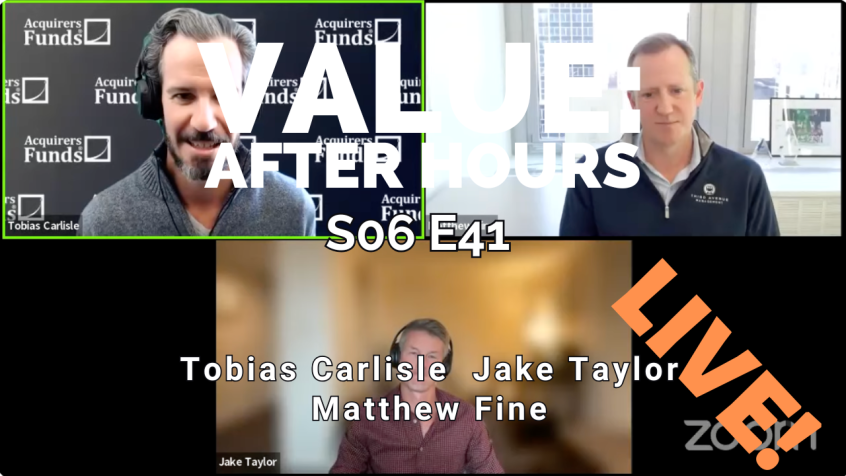During their recent episode, Taylor, Carlisle, and Matthew Fine discussed The Growing Divide in S&P 500 Valuations: What It Means for Value Investors. Here’s an excerpt from the episode:
Tobias: One of the little charts that you had showed the S&P 500 quartile spreads most expensive to cheapest. It’s a topic that we discuss regularly on this show. What did you, guys, deduce from your analysis of the quartiles of the S&P 500?
Matthew: Well, very candidly, originally, when I started looking at things like that. We’re bottom-up fundamental people. We’re not top-down quant people trying to carve up the market in that way. But when we were in 2017, 2018, 2019 and you felt as a fundamental value manager, like you’re beating your head against the wall, I don’t understand the relative performance. I don’t understand why these businesses I own have not been rerated even though, in some of those years, the absolute returns are pretty good, the relative were quite poor.
So, the first value for looking at something like that is to get me personally back off the ledge. Like, “What am I doing wrong? Is it me? Is it the world’s gone mad?”
Jake: What did you come up paraphrase that like, “You’re not interested in flows, but the flows are interested in you.”
[laughter]Matthew: Yeah, it’s absolutely right. But I thought it was absolutely fascinating. The more I think about that chart, the more important I actually think it is. There’s a lot of information in there. We could probably devote an entire call to it. But what I saw in 2017, 2018, 2019 was this spread just growing and growing and growing. It had been growing basically since 2012 or 2013. So, now, here we are a decade plus of expansion of that spread where expensive companies, meaning, that the most expensive quartile, the S&P 500, have just become relentlessly more expensive.
What’s also interesting about that chart, is if you have to look a little more closely, but the bottom quartile, the cheapest, has actually gotten cheaper over that time period. So, this notion, one side note or one piece that came out of it, this notion that low interest rates were driving long duration growth companies with cash flows way out in the future is what makes them long duration in people’s minds. Low interest rates should favor them disproportionately.
Maybe that’s true mathematically. I actually put that math in a white paper at one point looking at that, but low interest rates and shrinking discount rates inflate the value of all cash flows. But you can see in that chart, that’s not what’s happening. The cheapest stocks are actually becoming cheaper. They should inflate too, even if the most expensive should inflate more. But that didn’t happen. So, it’s not an interest rate phenomenon.
That chart, I believe is 35 years that you’re referring to, it goes back to basically 1990 and you saw it explode into the dot-com bubble, so harking back to my earliest days. I think we got to like a spread of like 16, so that could be 12 for the cheapest, 28 for the most expensive, something like that. And then, dot-com bubble burst and value strategies, the spread compressed.
While the spread is compressing, that’s very favorable for value strategies. A normal number for that spread is about 9. It went to 16 in the dot-com bubble, compressed. And it kept compressing, all the way right up to before the GFC. It got very low by historical standards, where there’s an argument to be made actually that in 2007 that cheap companies were not cheap enough on a relative basis or cheap was too expensive, if you will, on a relative basis.
I do suspect there’s something in there related to why a lot of value managers didn’t actually do quite as well in the GFC as some people had expected them to. That spread compression tells me a little bit about that. And then, it’s blown way out, got past the dot-com bubble by 2021, 2022. We reconciled about a good portion of that, but 2023 and 2024 has gone even wider. So, it just tells you a ton about why it’s really difficult for value managers on a relative basis, if expensive just keeps getting more expensive and if there is very little if any rerating happening in the cheaper end of the spectrum.
I know I said a lot there, but it’s mostly a US phenomenon. When you look at other markets, you see a little bit of it. When you look at an index for the world, you see a lot of it. But that’s just because the index– MSCI World, for example, is 2/3rd the US maybe even as high as 70%. So, you get a ton of influence from the US market in MSCI World. But on a foreign market basis, you really don’t see a lot of that, which does make me suspect, which I wrote in a recent letter, that the flows from active to passive $3 trillion in the last 10 years does probably have something to do with that. Although I just want to be careful, it’s hard to prove that and correlation does not equal causality. Yeah.
You can find out more about the VALUE: After Hours Podcast here – VALUE: After Hours Podcast. You can also listen to the podcast on your favorite podcast platforms here:
For all the latest news and podcasts, join our free newsletter here.
Don’t forget to check out our FREE Large Cap 1000 – Stock Screener, here at The Acquirer’s Multiple:



